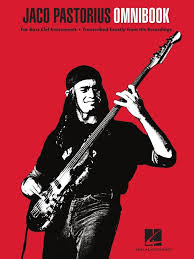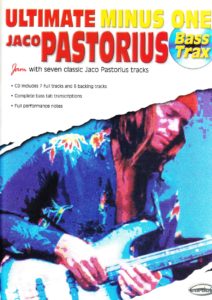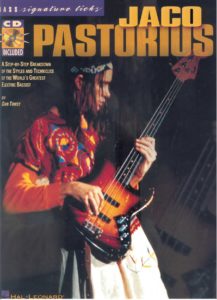Come join us now, and enjoy playing your beloved music and browse through great scores of every level and styles!
Can’t find the songbook you’re looking for? Please, email us at: sheetmusiclibrarypdf@gmail.com We’d like to help you!
Table of Contents
Jaco Pastorius Omnibook For Bass Clef Instruments Transcribed Exactly From His Recordings.

Contents List Download:
Search your favorite sheet music in the Sheet Music Catalog

Please, subscribe to our Library.
If you are already a subscriber, please, check our NEW SCORES’ page every month for new sheet music. THANK YOU!
Songs list:
- Amerika
- Barbary Coast
- Birdland
- Black Crow
- Black Market
- Blackbird
- Bright Size Life
- The Chicken
- Chromatic Fantasy
- Come On, Come Over
- Continuum
- Dara Factor One
- Donna Lee
- The Dry Cleaner From Des Moines
- 4 A.M.
- God Must Be A Boogie Man
- Good Question
- Harlequin
- Havona
- Hejira
- I Can Dig It Baby
- Invitation
- Kuru
- Liberty City
- Mood Swings
- Night Passage
- Okonkole Y Trompa
- Opus Pocus
- Palladium
- Port Of Entry
- Portrait Of Tracy
- Punk Jazz
- A Remark You Made
- River People
- Slang
- Speak Like A Child
- Speechless
- Talk To Me
- Teen Town
- Three Views Of A Secret
- Unquity Road
- (Used To Be A) Cha Cha
- Word Of Mouth
Jaco Pastorius: The Punker of Paradise – An Exhaustive Portrait of a Musical Revolutionary
To speak of Jaco Pastorius is to speak of a before and after in the history of music, specifically the history of the electric bass guitar. He was a supernova—a blinding, brilliant, and tragically brief force that forever altered the gravitational pull of his instrument. More than just a virtuoso, Jaco was a composer, an arranger, a visionary, and a tragic figure whose life story is as compelling as his music. He didn’t just play the bass; he reimagined it as a lead instrument capable of breathtaking melody, profound harmony, and rhythmic ferocity, all while expanding the very vocabulary of jazz and fusion.

Browse in the Library:
Or browse in the categories menus & download the Library Catalog PDF:
Biography: The Rise and Fall of an American Genius
Early Life (1951-1974)
John Francis Anthony Pastorius III was born on December 1, 1951, in Norristown, Pennsylvania, and raised in Fort Lauderdale, Florida. Music was in his blood; his father, Jack, was a stand-up drummer and singer who instilled in Jaco a love for jazz and big band music. A gifted athlete, Jaco’s musical path was set after injuries curtailed a potential career in sports.

Initially a drummer, he switched to bass in his teens after injuring his wrist playing football. His first significant electric bass was a 1962 Fender Jazz Bass, which would become his primary instrument, famously stripped of its frets around 1970. This act was not one of mere gimmickry; it was a conscious sonic choice. By removing the frets, Jaco achieved a vocal, cello-like sustain and the ability to manipulate pitch with a violinist’s nuance. He filled the fretboard holes with wood putty and coated the neck with marine epoxy, creating the smooth, fast surface that would facilitate his fluid style.
He cut his teeth in the vibrant Florida R&B and soul scene, playing with bands like Wayne Cochran and the C.C. Riders. This apprenticeship was crucial, grounding his phenomenal technique in the deep, unshakable pocket of groove music.
Meteoric Rise and Solo Work (1975-1981)
Jaco’s reputation as a local legend grew, but his ambition was galactic. In 1975, he traveled to New York to seek out his idol, bassist Jerry Jemmott. Finding Jemmott unavailable, he left a demo tape with pianist Paul Bley’s wife. This tape, containing early versions of “Donna Lee” and “Continuum,” found its way to Blood, Sweat & Tears drummer Bobby Colomby, who became a champion for Jaco and produced his self-titled debut album.

“Jaco Pastorius” (1976) is arguably the most important electric bass album ever recorded. It was a declaration of independence for the instrument. The album featured stunning reinterpretations of standards (Charlie Parker’s “Donna Lee”), soulful ballads (“Continuum,” “Portrait of Tracy”), and complex, Afro-Cuban-infused originals (“Opus Pocus”). It also showcased his formidable arranging skills on “The Chicken,” a funky tune by his friend and collaborator, Pee Wee Ellis. The album featured jazz luminaries like Herbie Hancock, Hubert Laws, and Sam & Dave, signaling that a new force had arrived.
His rising star caught the attention of Joe Zawinul and Wayne Shorter, who invited him to join their pioneering fusion band, Weather Report, in 1976. This period (1976-1981) marked the commercial and artistic peak of both the band and Jaco. His presence is felt most powerfully on the albums “Heavy Weather” (1977) and “Mr. Gone” (1978). It was on “Heavy Weather” that Jaco composed and performed his most famous piece, the melodic and soaring bass lead, “Birdland.” The track became a jazz standard and Weather Report’s signature song, a testament to Jaco’s genius as a composer.
On stage with Weather Report, Jaco was a whirlwind of energy, a showman whose technical prowess was matched only by his charismatic, and sometimes chaotic, stage presence. He was, as he famously proclaimed, “the greatest bass player in the world.” For a time, it was not hyperbole.

The Word of Mouth Era and Personal Decline (1982-1987)
Fueled by a growing ego and a desire for greater artistic freedom, Jaco left Weather Report in 1982. He formed his own big band, Word of Mouth, a project that realized his ambitions as a composer and arranger. The 1981 album “Word of Mouth” is a masterpiece of complex, orchestral jazz, featuring everything from a small combo to a full orchestra, with Jaco playing drums, piano, and, of course, bass.
However, this period also marked the beginning of his precipitous decline. Jaco had long exhibited signs of what is now believed to have been bipolar disorder. His behavior became increasingly erratic, grandiose, and self-destructive. He began self-medicating with alcohol and drugs, which exacerbated his mental health issues. His performances became unreliable; he would sometimes play brilliantly, other times descend into chaos or not show up at all. The music industry, once enamored with him, began to turn away.
Final Years and Tragedy (1987)
The last years of Jaco’s life were a heartbreaking descent into homelessness and mental illness. He was in and out of hospitals and often slept on the streets of New York and his hometown of Fort Lauderdale. On September 11, 1987, after a violent altercation with a nightclub bouncer, he was arrested and placed in a cell at the Broward County Jail. He fell into a coma and was transferred to a hospital, where he was diagnosed with a fractured eye socket and a swollen brain. He never regained consciousness and was taken off life support on September 21, 1987. He was 35 years old.
Music Style and Improvisational Licks
Jaco’s style was a synthesis of many elements, creating a voice that was entirely unique.
The Sound: His tone was immediately recognizable: a bright, punchy, mid-range-heavy sound with a sharp attack and a cello-like sustain. He achieved this through his fretless Fender Jazz Bass, flatwound strings, and specific amplifier settings (often Acoustic 360 amps).
Harmonics: Jaco was the undisputed master of natural and artificial harmonics. He could weave entire melodies using harmonics, as stunningly demonstrated in his solo piece “Portrait of Tracy.” He didn’t just use them for ethereal effect; he integrated them into his improvisations and compositions as melodic and harmonic devices.
Improvisational Vocabulary: His improvisational language was a direct extension of his heroes: saxophonists like Charlie Parker and John Coltrane, and trumpeter Miles Davis.
- Bebop Lines: He could play blisteringly fast, chromatically-enriched bebop lines with the facility of a horn player. His solo on “Donna Lee” is a masterclass in translating bebop to the bass.
- Pentatonic and Modal Freedom: On funkier tunes like “The Chicken” or “Come On, Come Over,” he would employ pentatonic and blues scales with a rhythmic swagger and ghost notes that were deeply rooted in James Jamerson’s Motown legacy, but with a modern harmonic twist.
- Chromaticism and Outside Playing: Like his idol John Coltrane, Jaco was fearless about playing “outside” the changes. He would use chromatic approaches, side-slipping, and superimposing triads to create tension and release. A classic Jaco lick might involve playing a phrase and then repeating it a half-step away, creating immediate dissonance and resolution.
Signature Licks:
- The “Birdland” Bassline: More than a lick, it’s a composition in itself. It’s a masterful blend of syncopation, chord tones, and a singable melody that defines the entire song.
- “Portrait of Tracy” Harmonics: The opening harmonic melody is a universally recognized bass etude. The way he combines natural and artificial harmonics to outline the chord changes is pure genius.
- “Teen Town” Bassline: On this Weather Report track, he plays a fiendishly difficult, syncopated, and propulsive line that functions simultaneously as a melody, a harmonic foundation, and a drum part.
Cooperation with Other Artists
Beyond his solo work and tenure with Weather Report, Jaco was a prolific collaborator.
- Joni Mitchell: His work with Joni Mitchell on her jazz-inspired albums “Hejira” (1976), “Don Juan’s Reckless Daughter” (1977), and “Shadows and Light” (1980) is some of the most sensitive and creative supporting work ever recorded. His bass lines don’t just accompany; they converse with her voice and guitar, creating a lush, atmospheric landscape.
- Pat Metheny: He played on Metheny’s iconic album “Bright Size Life” (1976), helping to define the sound of modern jazz guitar trio. His interplay with Metheny and drummer Bob Moses is lyrical and powerful.
- Others: His discography includes collaborations with a who’s who of jazz and fusion, including Ian Hunter, Albert Mangelsdorff, and even a posthumous appearance on “The Birthday Concert” with guitarist Mike Stern.
Chord Progressions and Music Harmony
Jaco’s harmonic conception was sophisticated and deeply informed by 20th-century classical music, bebop, and soul.
- “Birdland”: The harmony of “Birdland” is deceptively simple. It’s primarily a two-chord vamp (Fm7 and Ebm7), but the magic is in the melody and the orchestration. The bassline itself implies more complex harmony through its movement, using passing tones and enclosures to color the simple foundation.
- “Continuum”: This piece is a study in modal harmony. It’s built on a static Bb pedal point, over which a beautiful, melancholic melody unfolds. The harmony is implied by the melody and the inner voices, creating a sense of suspended, timeless beauty.
- “Three Views of a Secret”: This composition showcases his advanced knowledge of jazz harmony. It features lush, extended chords (major 7ths, 9ths, 13ths), key modulations, and a through-composed structure that rivals the work of great composers like Gil Evans. He used slash chords and polychords to create rich, orchestral textures from his bass.
Influences and Legacy
Influences: Jaco’s pantheon included bassists James Jamerson (for groove and melody), Jimmie Blanton (for elevating the bass as a solo instrument), and Paul Chambers; saxophonists Charlie Parker and John Coltrane; and composers like Igor Stravinsky and Paul Hindemith.
Legacy: Jaco’s legacy is immeasurable.
- The Fretless Revolution: He single-handedly popularized the fretless electric bass, inspiring a generation of players like Gary Willis, Matthew Garrison, and Richard Bona.
- Virtuosity as Standard: He proved that the electric bass could be a vehicle for extreme technical virtuosity without sacrificing groove or musicality.
- The Composer-Bassist: He legitimized the bassist as a primary composer and arranger in a band context.
- Every Bassist After Him: It is nearly impossible to find a professional bassist born after 1955 who was not profoundly influenced by Jaco Pastorius, either directly or through the players he inspired. His influence permeates jazz, fusion, funk, and progressive music.
Works, Filmography, and Discography
Most Known Compositions and Performances:
- “Portrait of Tracy” (solo bass piece)
- “Continuum”
- “Birdland” (with Weather Report)
- “Teen Town” (with Weather Report)
- “The Chicken” (as popularized by Jaco)
- “Donna Lee” (his bebop interpretation)
- “Three Views of a Secret”
- “Opus Pocus”
Filmography:
While Jaco’s life is the subject of several documentaries, his direct filmography is limited.
- “Jaco: The Film” (2014): The definitive documentary on his life, produced by Metallica’s Robert Trujillo, featuring extensive interviews, archival footage, and testimonials from family and musical peers.
- “Weather Report: Live at Montreux 1976”: Captures Jaco at the absolute peak of his powers with the band.
Selective Discography:
As a Leader:
- Jaco Pastorius (1976)
- Word of Mouth (1981)
- Invitation (1983) [Live]
- The Birthday Concert (1995) [Recorded 1981]
With Weather Report:
- Black Market (1976)
- Heavy Weather (1977)
- Mr. Gone (1978)
- 8:30 (1979) [Live]
As a Sideman (Key Albums):
- Pat Metheny, Bright Size Life (1976)
- Joni Mitchell, Hejira (1976)
- Joni Mitchell, Don Juan’s Reckless Daughter (1977)
- Joni Mitchell, Shadows and Light (1980) [Live]
- Ian Hunter, All American Alien Boy (1976)
Jaco Pastorius: The Punker of Paradise
Jaco Pastorius was a complex paradox. He was “The Punker of Paradise,” a title he gave himself, reflecting the clash between his aggressive, rebellious spirit and his quest for sublime, beautiful music. He was a genius who could hear entire orchestras in his head and translate them through four strings, yet he was ultimately unable to quiet the storms within his own mind.
His story is a classic, and tragic, tale of artistic brilliance undone by personal demons. But to focus solely on his demise is to miss the point. The point is the music he left behind—a body of work that remains as vital, challenging, and beautiful today as it was decades ago. Jaco didn’t just change how the bass is played; he changed what music could be, proving that from the lowest frequencies could spring the highest art. He was, and remains, the greatest bass player in the world.
Jaco Pastorius in Offenbach, 1978
Jaco Pastorius performing “Slang” (bass solo) during a Weather Report at the Stadthalle Offenbach in Offenbach am Main, West Germany on September 29, 1978.
00:00 Dolores by Wayne Shorter 03:10 Portrait of Tracy by Jaco Pastorius 03:29 I’m So Glad We Had This Time Together from the Carol Burnett Show 04:31 Improvisation 05:40 Sing a Simple Song by Sly & The Family Stone 05:53 Had to Cry Today by Blind Faith 05:57 Funky Broadway by Wilson Pickett 06:06 Them Changes by Buddy Miles 06:28 Third Stone from the Sun by the Jimi Hendrix Experience 08:32 The Sound of Music by Rodgers and Hammerstein 08:47 Finale
Jaco Pastorius – Live In Montreal (1982)
Recorded Live At The International Montreal Jazz Festival, July 1982.
Jaco Pastorius: Bass Peter Erskine: Drums Don Alias: Percussion Bobby Mintzer: Saxophone Othello Molineaux: Steel Drums Randy Brecker: Trumpet
01 – Chicken 00:00 02 – Donna Lee 06:41 03 – Bass Solo 21:11 04 – Mr. Phone Bone 27:18 05 – Fannie Mae 45:22
Jaco Pastorius Band – “So What?” TV show Belgium (1985)
Jaco Pastorius: Bass, Keys, Perc Paco Sery: Drums Jon Davis: Piano Paul Mousavizadeh: Guitar Azar Lawrence: Sax, Perc Guests: Toots Thielemans: Harmonica * Michel Hatzigeorgiou: Bass **
01. Dolphin Dance 00:00 02. If You Could See Me Now 10:59 03. Drum solo 15:40 04. Drum + sax solo 19:38 05. Three Views of a Secret 25:51 * 06. Bass solo 33:12 07. Continuum 33:45 ** 08. America 37:18 ** 09. Twins 41:40 10. Liberty City 42:51
